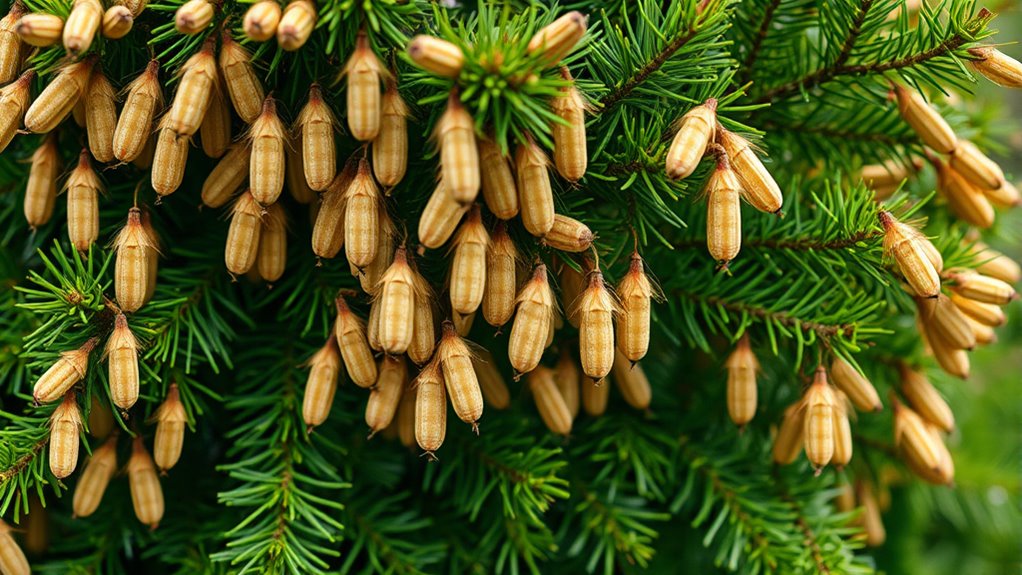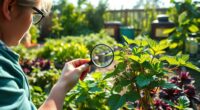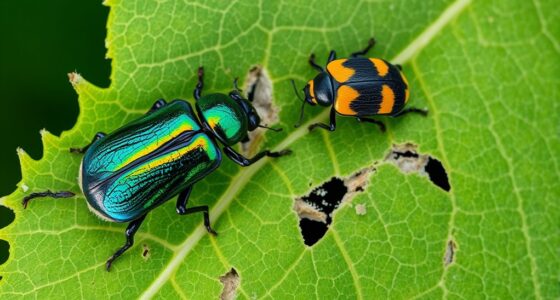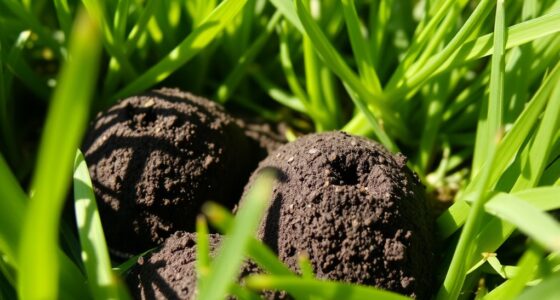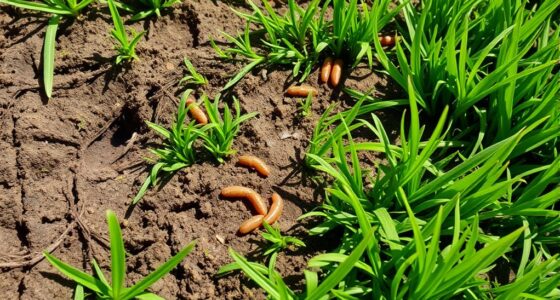If you notice silken bags hanging from your arborvitae or juniper, along with brown, needle-like foliage, you likely have a bagworm infestation. These pests feed on your plants and weaken their structure, but early detection helps; look for tiny, gourd-shaped bags on branches. Encourage natural predators like birds or consider applying eco-friendly insecticides such as Bacillus thuringiensis when larvae are small. Keep an eye out for more tips to protect your trees effectively.
Key Takeaways
- Look for brown, needle-like foliage and hanging silken bags to identify bagworm infestations on arborvitae and juniper.
- Early detection allows for manual removal of bags and targeted applications of Bacillus thuringiensis (Bt).
- Encourage natural predators like birds and parasitic wasps to help control bagworm populations sustainably.
- Apply appropriate insecticides during early larval stages for effective control, following product instructions carefully.
- Regularly monitor trees in late spring and early summer to prevent severe defoliation and damage.

If you notice brown, needle-like foliage on your arborvitae or juniper, bagworms may be the culprit. These pests create distinctive, silken bags that hang from branches, often resembling tiny, tattered gifts. The presence of these bags is a clear sign that bagworms have taken hold and are feeding on your plants. Left unchecked, they can defoliate entire sections, weakening your trees and ruining their appearance. The good news is that managing bagworms doesn’t always require harsh chemicals; understanding your options is key.
Brown, needle-like foliage signals bagworm infestation on arborvitae and juniper. Act early to protect your trees.
One effective approach is to encourage natural predators. Birds, especially chickadees, nuthatches, and warblers, find bagworms to be a tasty snack. These birds can markedly reduce bagworm populations if you provide a bird-friendly environment, such as bird feeders and native plants that attract them. Additionally, some beneficial insects, like certain wasps, are natural parasitizers of bagworm eggs and larvae, helping to keep their numbers in check. Creating an environment that supports these predators can be a sustainable, eco-friendly way to control infestations without resorting to chemicals.
However, if the infestation becomes severe or you’re seeking faster results, chemical treatments might be necessary. Insecticides containing bacillus thuringiensis (Bt) are often recommended for early-stage bagworm larvae. When applied properly and at the right time—typically when larvae are small—you can effectively halt their development. Be sure to follow the instructions carefully to minimize impact on non-target insects and pollinators. In cases where chemical treatments are preferred, systemic insecticides can also be used, but they should be applied with caution, considering the potential environmental impact and safety for pets and children.
Timing is critical in bagworm control. Early detection allows for more targeted and effective interventions, whether using natural predators or chemical treatments. Keep an eye on your trees during late spring and early summer, when bagworm larvae hatch and begin feeding. Removing bags by hand is another immediate step, especially in small infestations; simply pick off the bags and dispose of them far from your plants to prevent re-infestation. Additionally, understanding the timing of larval emergence can significantly improve your chances of successful control.
Frequently Asked Questions
How Do Bagworms Spread Between Different Trees?
You should know that bagworms spread mainly through their lifecycle. After hatching from eggs, the larvae crawl to nearby trees, often riding on wind, birds, or other animals. Infestation indicators, like defoliation or silk bags hanging from branches, signal their presence. As the larvae mature, they leave behind egg cases, which can be carried to new trees by wind or contact, helping the infestation spread between different trees.
Can Bagworms Affect Other Types of Conifers?
Yes, bagworms can affect other conifers. During their life cycle, bagworms create distinctive silk and plant material bags, which are obvious infestation signs. You might notice their feeding damage or the bags hanging from branches. These pests aren’t picky, so they could infest different conifer species, not just arborvitae or juniper. Regular inspection can help catch infestations early, making it easier to manage and prevent spread.
What Are Natural Predators of Bagworms?
You can use natural control by encouraging predator species like birds and predatory insects, such as wasps and beetles, to help manage bagworm populations. These natural predators feed on bagworm larvae and pupae, reducing their numbers effectively. To attract these beneficial predators, avoid broad-spectrum insecticides and plant native trees and shrubs that provide habitat. Promoting predator species creates an eco-friendly way to control bagworms naturally.
How Early Can Bagworm Infestations Be Detected?
You can detect bagworm infestations early by observing symptom identification, such as tiny silk bags hanging from your plants’ branches. Usually, you’ll notice these bags in late spring or early summer when bagworms start to hatch. Keep a close eye on your arborvitae and junipers, and check regularly for new silk bags or chewed foliage. Early detection allows you to take prompt action before the infestation worsens.
Are Chemical Controls Safe for Surrounding Wildlife?
Chemical controls can be safe for surrounding wildlife if you choose products with targeted active ingredients and follow label instructions carefully. Many pesticides are designed to minimize risks to non-target species, but always prioritize wildlife protection by applying them during times when beneficial insects or animals are less active. Always check chemical safety labels and opt for environmentally friendly options to guarantee you protect both your plants and local wildlife effectively.
Conclusion
If you spot bagworms on your arborvitae or juniper, act quickly—they can defoliate trees in just a few weeks. Did you know that a single bagworm can produce up to 1,000 eggs? That means one infestation can quickly grow out of control. Regular inspections and early treatment are your best defenses. Stay vigilant this season to keep your evergreens healthy and thriving. Don’t wait—your trees will thank you!
